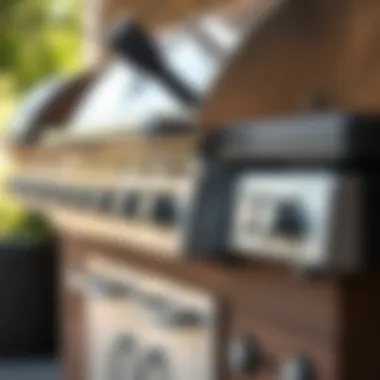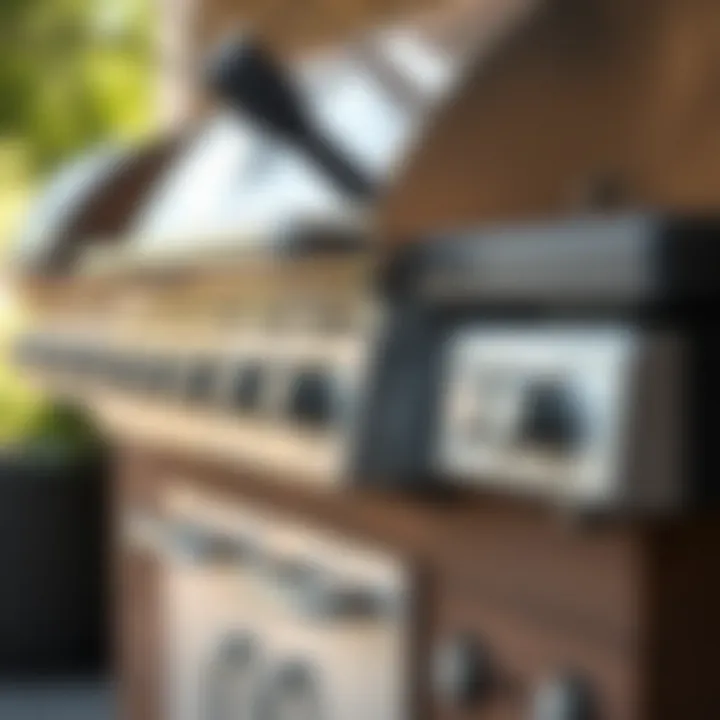Exploring Modular Grill Stations: A Complete Guide


Intro
In the realm of outdoor cooking, modular grill stations have carved a niche of their own, merging functionality with aesthetic appeal. These grill setups are no longer merely about tossing a few burgers on a basic grill; they encompass a variety of components that can turn a simple backyard barbecue into a culinary escapade. Whether you are an earnest home cook or looking to elevate your gatherings as a seasoned chef, understanding the ins and outs of modular grill stations is key.
As we journey through this exploration, imagine how customizing your grilling space could transform not just your meals but your entire outdoor experience. From designing a layout that caters to your cooking style to knowing how to maintain the installation, we will glean insights that can guide anyone through the decision-making process of building or purchasing a modular grill station.
Stay tuned as we delve into the intricacies of grill station components, design options, and the advantages they bring to the table—literally.
Foreword to Modular Grill Stations
When it comes to outdoor cooking, the rise of modular grill stations has added a new dimension to how we approach grilling and entertaining. These setups are not just about cooking; they embody a lifestyle that embraces culinary creativity and social interaction. In this article, we will explore the essentials of modular grill stations, focusing on why they are becoming a staple in many backyards.
Definition and Purpose
Modular grill stations essentially refer to customizable cooking frameworks that can include everything from grills to storage compartments and prep areas. Think of them like an assembled puzzle of kitchen essentials that can be tailored to fit individual needs and spaces. The main purpose of these modular systems is to create a seamless cooking experience outdoors, allowing enthusiasts to easily switch between grilling, smoking, and even food prep without any hassle.
But it’s not just about functionality; these installations can elevate your outdoor area, providing a cohesive look that aligns with your home’s design. With modular grill stations, you’re not just investing in a cooking tool; you’re investing in an experience.
Growing Popularity in Outdoor Cooking
You might wonder why these grill stations are gaining traction. It’s simple; the trend toward outdoor living is booming. Homeowners are discovering the joy of cooking outside, and what better way to do that than with a specialized setup designed for convenience and efficiency?
Moreover, the versatility of modular grill stations has contributed to their popularity. You can mix and match components to suit your cooking habits and style. Whether you're a weekend barbecue warrior or a serious pit master, these stations can adapt to your culinary needs.
Some reasons behind their surging popularity include:
- Customizability: They can be tailored to fit your specific outdoor layout and personal taste.
- Increased Entertainment: These stations create a focal point for gatherings, encouraging socializing and cooking together with family and friends.
- Functionality: With added features like sinks, fridges, and prep spaces, cooking outdoors becomes as seamless as in the kitchen.
What’s more, the social aspect cannot be overlooked. In an age where shared experiences are treasured, modular grill stations help foster connection through meals shared in the fresh air. Each grill or prep area directs the flow of cooking, and this orchestration invites interaction — each friend or family member can have a role to play in creating a memorable dining experience.
Key Components of Modular Grill Stations
When exploring modular grill stations, it's essential to understand the foundational elements that make them effective and appealing for both novice and experienced barbecue enthusiasts. The various components of these setups not only enhance functionality but also significantly impact the overall user experience in outdoor cooking environments. By focusing on crucial elements like grill types, storage solutions, and preparation areas, this section provides insight into how to maximize your outdoor culinary adventures.
Grill Types and Features
The first consideration in a modular grill station is the grill itself. Different types of grills serve distinct purposes, and choosing the right one can elevate your outdoor cooking game. Here’s a closer look at some popular grill types:
- Gas Grills: These are known for their convenience and quick heat-up times. They often come with multiple burners, allowing for temperature control.
- Charcoal Grills: For those who appreciate that distinct smoky flavor, charcoal grills are a savory choice, albeit requiring more time to prepare.
- Pellet Grills: Combining aspects of gas and charcoal, these grills use wood pellets for fuel, offering versatility in cooking styles, from grilling to smoking.
- Electric Grills: Ideal for smaller spaces or those with restrictions on open flames, electric grills are easy to use and clean.
Each grill type has its own set of features, such as side burners, rotisserie attachments, and infrared technology, that can greatly enhance cooking efficiency and versatility. Choosing a grill that aligns with your cooking style and preferences is vital for getting the most out of your modular grill station.
Storage Solutions and Accessories
Efficiency in outdoor cooking is not just about the grill; it also heavily depends on adequate storage solutions. Modular grill stations often incorporate various storage options, which can dramatically improve usability. Here’s what to keep in mind:
- Cabinets: Built-in cabinets offer a concealed space for tools, utensils, and marinades, keeping everything within reach yet out of sight.
- Drawers: Pull-out drawers can accommodate everything from spices to grilling accessories, evolving the organization of your outdoor kitchen.
- Shelving Units: Open shelves provide easy access to frequently used items while simultaneously displaying herbs or decorative plants.
Additionally, incorporating accessories like spice racks, tool hooks, and trash bins can streamline the cooking process. Managing storage smartly is key for maintaining a tidy and effective grill station.
Counter Space and Preparation Areas
The cooking stage is where the magic happens, but without adequate counter space, it becomes a juggling act. A well-designed modular grill station will feature ample counter areas for prep and serving. Here are some considerations:
- Material Choices: Opt for weather-resistant materials like stainless steel or stone that withstand the elements while providing a sleek look.
- Workspace Design: An L-shaped counter can create a natural workflow, allowing you to transition seamlessly between preparation and grilling.
- Integrated Sinks: Including a small sink in your design allows for easy cleanup and food preparation, which minimizes mess.
Having these elements readily available means fewer trips into the house and more time enjoying the outdoors. Ultimately, the better equipped your grill station is, the more enjoyable the experience will be.
Investing in the right components of a modular grill station is crucial for creating a seamless cooking experience that caters to your personal style and needs.
In summary, modular grill stations are more than just a convenient setup; they are engineered to elevate your outdoor kitchen capabilities. By focusing on the types of grills, effective storage solutions, and ample prep areas, you can create a versatile environment that enhances your culinary excursions.
Advantages of Modular Grill Stations


When delving into the realm of outdoor cooking, modular grill stations stand out as a feature that invites attention. They offer much more than mere grilling surfaces and promise a blend of practicality and adaptability. The advantages of these stations play a pivotal role in enhancing the cooking experience for everyone from passionate home cooks to professional chefs.
Customization and Flexibility
Customization is one of the cornerstones of modular grill stations. Unlike traditional grill setups that often come as a one-size-fits-all solution, modular units allow users to tailor their outdoor cooking spaces according to specific needs and preferences. Picture this: a grilling station complete with a smoker, a pizza oven, and storage for utensils all in one seamless arrangement. Such versatility not only meets various cooking styles but also reflects the personality of the homeowner.
Moreover, these structures can adapt as needs change. For instance, if you decide to host larger gatherings or change your cooking style, adding or swapping modules can be done without major renovations. This means less hassle when transforming your outdoor setup for different occasions—one day you might want to roast a whole pig, and the next, you’re just flipping burgers for a small family gathering. Flexibility without the fuss adds a layer of convenience that traditional grills simply can’t hope to match.
Space Optimization in Outdoor Areas
In many urban settings, space is at a premium. Modular grill stations shine brightly in this aspect, skilled in maximizing every square inch of available outdoor area. Instead of sacrificing lawn space for that bulky grill, homeowners can install sleek, multi-functional stations that utilize vertical space effectively.
For example, built-in shelves and cabinets can hold all your grilling essentials, eliminating clutter and keeping everything handy. This kind of design not only improves functionality but enhances the aesthetics of your outdoor area, creating an inviting and organized environment. When entertaining guests, having a structured yet open layout allows for easier movement and interaction while cooking, making gatherings feel seamless and connected.
Enhanced Social Interaction
At the heart of every cookout lies social interaction. Modular grill stations are crafted to promote mingling and communication among guests. Many designs put the grill in the center, allowing the chef to be part of the social circle rather than isolated on the sidelines. This arrangement encourages conversations and laughter while meals are prepared, drawing everyone closer together.
Imagine standing around a grill, discussing flavors while a good steak sizzles in front of you. The setup can even incorporate seating areas within arm’s reach, fostering a more engaging atmosphere. This isn’t just about cooking; it’s about building memories, strengthening bonds, and making dining a shared experience rather than a solitary task.
"A well-designed outdoor cooking space transforms not just meals but also relationships, inviting friends and family to gather round and share stories."
Design Considerations for Modular Grill Stations
When it comes to setting up a modular grill station, design considerations aren’t just about aesthetics; they encompass a range of essential factors that can greatly affect functionality and satisfaction. The right design ensures that the grill station meets the user’s needs while blending seamlessly into the outdoor environment. Understanding these considerations can lead to an enhanced cooking experience that is as enjoyable as it is practical.
Architectural Compatibility
One of the first steps in designing a modular grill station is ensuring its architectural compatibility with the surrounding environment. This means considering the existing structures, styles, and overall layout of the outdoor area. For instance, a sleek, modern grill station might clash with a rustic cottage-style home. The goal is to create a harmonious visual language.
Key elements to keep in mind include:
- Alignment with Home Style: Match the grill station materials and design features with those of your home. If the house boasts a contemporary look, choose clean lines and modern finishes. Conversely, for a traditional home, opt for stone or wood elements that reflect its character.
- Scale and Dimensions: Think about the size of the grill station in proportion to the outdoor space. A massive unit can overwhelm a small yard while a diminutive grill might get lost in a larger area.
- Flow of Space: The design should allow for easy navigation, encouraging social interaction. Consider placing the grill station in a spot that invites guests to gather around instead of isolating it from the main outdoor living space.
Material Selection for Durability
Selecting the right materials is crucial for longevity and functionality in a modular grill station. Different materials offer various benefits, impacting not just durability but also maintenance. Here’s how to approach material selection:
- Stainless Steel: This is a popular choice for grills due to its resistance to rust and staining. It’s not only easy to clean but also maintains its appearance over time, even with heavy use.
- Stone or Brick: These materials lend a classic aesthetic and exceptional durability. They withstand harsh weather conditions and add a traditional, timeless appeal to the outdoor space.
- Wood: While offering warmth and beauty, wood requires more maintenance to prevent decay. If using wood, consider treated types or species such as teak or cedar that are more resistant to the elements.
"The best material for your grill station is one that balances durability with the aesthetic you wish to promote."
Color and Style Choices
Color and style can dramatically influence the overall ambiance of an outdoor cooking area. When choosing colors and styles, think about:
- Personal Aesthetic: Select colors that resonate with your personal taste and the atmosphere you wish to create—warm, inviting tones for relaxed family gatherings or sleek monochrome for a modern vibe.
- Landscape Colors: Take into consideration the natural surroundings. Colors found in plants, flowers, or other structures in your yard can guide your palette. A neutral station might work well amid vibrant greenery while bold colors can complement a contemporary landscaping plan.
- Finish and Texture: The finish of the materials can also impact the look and feel. Matte finishes can create a more subtle, understated appearance, while glossy surfaces can add a touch of sophistication.
Incorporating these design principles ensures that your modular grill station is not only functional but also a beautiful asset to your outdoor space. The design should invite you and your guests to gather around, fostering a warm, welcoming atmosphere for all.
By considering architectural compatibility, selecting durable materials, and thoughtfully choosing colors and styles, you set the foundation for creating a grill station that is both practical and aesthetically pleasing.
Installation Process of Modular Grill Stations
The installation process of modular grill stations is a crucial phase that requires careful planning and execution. Getting it right can significantly enhance your outdoor culinary experience. The placement, structure, and integration of utilities all contribute to how the grill station performs. This section will explore the detailed steps involved in the installation, emphasizing the importance of each element for optimal functionality and safety.
Site Preparation
Proper site preparation lays the groundwork for a successful modular grill station installation. Like the foundation of a house, this phase is essential for stability and durability. Start by assessing the area intended for the grill station; ensure it is flat, dry, and free from debris.
- Choosing the Right Location: The grill should ideally be placed away from overhanging trees or any structures that might catch fire. A distance of at least 10 feet is advisable to allow for airflow and cooking ease.
- Ground Surface: A solid surface, such as concrete or pavers, can provide the necessary support for your grill station. If the surface is too soft, it might lead to shifting or settling over time, complicating your cooking experience.
- Spatial Planning: Consider the space around the grill. Adequate room for movement and access to amenities like propane tanks or power sources is critical. Leaving at least three feet of clearance around the station enhances comfort.
Assembling Modular Units


After ensuring the site is ready, the next step is assembling the modular units. Modular grill stations often come in components that fit together seamlessly. It's almost like putting together a puzzle where every piece has its place.
- Instructions and Tools: Refer to the manufacturer's instructions. Most kits will provide a comprehensive guide to ensure proper assembly. Necessary tools often include a drill, screwdriver, and level.
- Connecting Components: Begin by anchoring the frame, usually the backbone of the station. This is crucial since it provides stability. Then, methodically attach the grill, storage units, and counters as outlined. Make sure every connection is tight and secure to prevent future complications.
- Tightening for Stability: As you assemble, closely check that all fixtures are properly tightened. Loose parts can lead to unsteady setups or even dangerous accidents during cooking sessions.
Connecting Utilities and Safety Measures
Once the installation and assembly are complete, attention turns to connecting utilities, a vital step for ensuring the efficiency and safety of your modular grill station. Depending on your setup, this may include connecting gas lines, electrical components for lights or refrigerators, and water lines.
- Gas Connections: For gas-powered grills, it's important to connect them according to your local regulations. If you’re not familiar with gas installation, it’s wise to consult a professional. An improperly connected gas line can pose a serious safety risk.
- Electrical Setups: If your grill station includes electric appliances, ensure that all wiring adheres to local codes. Using outdoor-rated extension cords if needed, and never overload circuits can prevent potential hazards.
- Safety Features: Consider incorporating safety features like shutoff valves for gas and circuit breakers for electrical setups. Additionally, keeping a fire extinguisher accessible is recommended, preparing for any unpredictability during cooking.
"Every step of the installation process is crucial; overlooking one can lead to a lesser cooking experience than expected. Pay attention to each detail."
In summary, the installation process is more than just piecing together parts; it's about creating a functional culinary space that aligns with safety standards and personal cooking preferences. Following each step thoughtfully not only guarantees a sturdy setup but also enhances your overall enjoyment of outdoor cooking.
Maintenance and Care for Modular Grill Stations
Maintaining and caring for modular grill stations is crucial for ensuring both longevity and optimal performance. Just like any kitchen appliance, neglect can lead to diminished functionality and durability over time. By sticking to a regular maintenance schedule, grill owners make sure their investment continues to pay dividends, season after season.
Routine Cleaning Techniques
Keeping your modular grill station clean is not just about aesthetics; it directly impacts food safety and flavor. Regular cleaning can help remove grease buildup, prevent rust, and keep harmful bacteria at bay. Here are some key techniques to keep your grill spick and span:
- Daily Wipe-Down: After each use, a quick wipe down of surfaces with warm soapy water stops grime from becoming a larger issue. Pay attention to the grates, where food residue tends to cling.
- Deep Cleaning: At least once a month, do a thorough deep clean. Remove grates and wash them in warm, soapy water, soaking them if necessary. A brass brush or grill scraper can aid in getting rid of any stubborn bits.
- Burn-Off Method: Preheat the grill to a high temperature (around 500°F) with the lid closed for about 15-20 minutes after cooking. This helps to incinerate residue, making it easier to clean.
Remember, the materials of your grill station might dictate cleaning products. Using a harsh chemical on stainless steel can lead to discoloration. When in doubt, stick with mild solutions.
Addressing Wear and Tear
Modular grill stations undergo heavy usage, which can lead to wear and tear over time. Addressing these issues promptly ensures safety and enhances aesthetics:
- Inspect Regularly: Routine inspections are vital. Look for signs of rust, cracks, or loose components. Catching these early can prevent costly replacements.
- Replace Worn Parts: If grates or burners start to show signs of fatigue, replace them immediately. Avoid risking uneven cooking and potential flare-ups.
- Protective Covers: When not in use, consider utilizing a protective cover that fits snugly over your grill station to shield it from the elements. Sun, rain, and snow can be harsh.
Making small repairs as they arise not only extends the life of the grill station but also maintains its appearance and performance.
Seasonal Preparations
As seasons change, so too should the approach to caring for your modular grill station. Potential weather extremes can take a toll, and preparing for them is essential:
- Pre-Summer Check: Before the outdoor cooking season kicks off, inspect for any problems, clean thoroughly, and restock grilling supplies. This is also a good time to check gas connections if you have a gas grill.
- Winterization: If you live in an area where winters are brutal, proper winterization is necessary. Clean and dry your grill completely, cover it, and store it in a sheltered place if possible. If left outside, ensure it's insulated against moisture.
- Spring Restoration: When the warmth returns, remove any coverings and perform a detailed inspection for mold or mildew. Ensure cleaning before firing it up again.
Taking the proper steps with seasonal preparations not only enhances safety but also sets you up for success the moment the grill is ignited.
In summary, proactive maintenance and care increase the lifespan of your modular grill station while ensuring every cook-out is efficient and enjoyable.
Comparing Modular Grill Stations to Traditional Grill Setups
When it comes to outdoor cooking, modular grill stations stand at the forefront, innovating how we think about grilling dynamics. As more homeowners embrace outdoor lifestyles, understanding how modular setups stack against traditional grill configurations becomes crucial. The nuances between these two approaches not only highlight efficiency but also enhance the overall cooking experience.
Functional Differences
Modular grill stations distinguish themselves from traditional setups through their design and versatility. Instead of a singular fixed grill, modular stations comprise distinct components that offer comprehensive functionality tailored to various cooking styles.
- Customization: Modular systems can be organized in a way to accommodate different grill types—be it charcoal, gas, or even electric. In contrast, a traditional grill setup typically confines you to one type, limiting the cooking methods available.
- Multifunctionality: Many modular stations integrate side burners, pizza ovens, smokers, and even chillers for beverages. Traditional grills usually refrain from such widespread utility, focusing solely on grilling.
- Space Efficiency: When arranged properly, modular stations make the most of the given area. They can occupy smaller outdoor spaces better than traditional configurations, which might require larger footprints due to their fixed nature.
These functional differences underscore why an increasing number of outdoor cooking enthusiasts are leaning towards modular constructions.
Cost Analysis
Although a traditional grill seems like a cost-effective solution at first glance, the hidden costs can shift the equation substantially. Modular grill stations might require a higher initial investment, but this can lead to money-saving scenarios in the long term.
- Initial Investment: A good quality traditional grill might appear cheaper initially, but the cost can quickly balloon once you factor in necessary accessories and replacement parts.
- Longevity and Durability: Modular units often employ higher-quality materials due to customization requirements, resulting in less frequent replacements. The modular stations are typically built with longevity in mind to withstand seasons of use.
- Versatility: Investing in a modular station means you’re not just paying for a grill; you’re also investing in various cooking functions like built-in storage, prep areas, and even integrated sinks. This multifaceted utility can make up the difference in costs over time.
While the sticker price might make heads turn, a deeper dive into costs illustrates that modular setups often provide better value for the discerning buyer.


Long-Term Value Considerations
When assessing the longevity of investments in outdoor cooking, evaluating long-term value is essential. Modular grill stations typically outperform traditional grills for several reasons.
- Upgradability: Modular systems allow you to swap components or add new features over time, adapting to your cooking aspirations without needing a complete overhaul. Traditional grills often lack this flexibility, forcing you to replace the entire unit.
- Enhanced Functionality: With features that exceed grilling alone, a modular setup promises elevated culinary experiences and broader gatherings, delivering value far beyond simply cooking burgers.
- Increased Property Value: Homebuyers often view well-integrated outdoor kitchens as a premium feature. A modular grill station can enhance the aesthetic and functional appeal of outdoor spaces, potentially increasing property value upon sale.
Ultimately, while the long-term value considerations of modular grill stations may pose a higher initial investment, the rewards—ranging from flexibility to increased home appeal—offer a compelling argument for their adoption.
Incorporating Modular Grill Stations into Outdoor Spaces
As outdoor cooking gains momentum, the relevance of modular grill stations becomes ever clearer. These fixtures don't just serve a practical purpose; they're pivotal in crafting an inviting atmosphere for gatherings, family meals, and solo culinary adventures. Instead of a standard grill tucked away in the corner, a well-placed modular grill station transforms the outdoor space, showcasing the owner’s taste and enhancing the overall setting.
The benefits of incorporating a modular grill station into an outdoor layout are multifaceted. Here are several critical points:
- Functional Elegance: Modular grill stations can serve as a centerpiece, blending functionality with aesthetic appeal while significantly improving the usability of the area.
- Customization: Homeowners can personalize their modular setups to cater to their specific needs, whether it's an expansive countertop for food prep or integrated storage for utensils.
- Increased Real Estate Value: Quality outdoor cooking spaces can elevate property values, making them desirable for potential buyers.
- Enhanced Cooking Experience: With tailored designs, grill stations make cooking outdoors more efficient and enjoyable, whether you're searing a steak or roasting vegetables.
Designing Outdoor Layouts
When embarking on the design of outdoor layouts featuring modular grill stations, careful thought should go into positioning. A well-planned layout not only maximizes cooking and prep space but also ensures easy access for both the cook and guests. For instance, situating a grill station near a dining area enhances the flow of service, making for a smoother experience.
Consider the following elements when designing your layout:
- Proximity to the Kitchen: If convenience is the name of the game, place your grill station close to the kitchen entrance. This arrangement allows for quick transitions between cooking and serving.
- Zoning: Create separate zones for cooking, dining, and relaxing. This ensures that the area remains organized, and activities can flow without obstruction.
- Access to Power and Water: If possible, integrate utilities such as water and electricity for additional equipment like refrigerators or sinks.
Integration with Landscaping
A modular grill station should harmonize with the surrounding landscape rather than stand out as an afterthought. Thoughtful landscaping can augment the visual appeal of your cooking area. Here are some strategies to consider:
- Natural Materials: Use materials that are in line with the rest of your outdoor space. For instance, stone or wood finishes can blend seamlessly with a garden or backyard.
- Plant Life: Incorporate plants around the grill station. Tall plants can create privacy while also enhancing aesthetics.
- Hardscapes: Pathways or patios leading to the grill station can define the area and create a more cohesive environment. It also invites visitors to move naturally between different outdoor sections.
Creating Functional Flow
Creating functional flow is about ensuring that movement around the grill station is intuitive and uncomplicated. Guests should be able to navigate the area without hindrance while enjoying the culinary shenanigans happening nearby.
Key considerations for functional flow include:
- Circulation Space: Ensure enough clear space around the grill so that multiple people can move in and out without bumping elbows. Four feet should generally suffice for primary traffic routes.
- Serving Strategies: Think about how food will be served. Setting up a bar or countertop adjacent to the grill allows for efficient service while keeping the cook engaged with guests.
- Seating Arrangements: Position seating in a way that doesn’t obstruct access to the grill, while also encouraging conversation and engagement.
"The right layout can change the dynamics of your outdoor gatherings, turning simple dinners into memorable experiences."
By mindfully incorporating modular grill stations into your outdoor spaces, you not only improve the function of your environment but also create a delightful setting that turns every meal into an event.
Case Studies: Successful Modular Grill Station Implementations
Examining real-world examples of modular grill stations provides invaluable insight into their practicality and effectiveness. These case studies not only highlight the versatile design possibilities but also reinforce the benefits of modular grill systems for various outdoor settings. The importance of these case studies lies in their demonstration of how modular stations can enhance cooking experiences, improve outdoor functionality, and accommodate diverse user needs. From private backyards to busy commercial environments, analyzing successful installations can inspire and inform potential buyers and designers alike.
Residential Examples
In residential settings, modular grill stations often reflect personal style while maximizing functional space. Take, for example, a contemporary home in a suburban neighborhood in North Carolina. The homeowners wanted to create a functional outdoor dining area that mirrored the sleek design of their home interiors. By opting for a modular grill station tailored with stainless steel finishes and integrated storage solutions, they not only achieved an eye-catching focal point but also ensured that all grilling tools were close at hand.
- Key Features of this installation included:
- An integrated ice chest for easy access to beverages.
- A side burner for additional cooking space, allowing multiple dishes to be prepared simultaneously.
- Weather-resistant cabinetry that stands strong against the elements.
This residential example demonstrates how modular grill stations can be both aesthetically pleasing and functional, encouraging outdoor entertaining and culinary creativity.
Commercial Installations
Moving to the commercial realm, a popular brewery in Colorado embraced modular grill stations to elevate its outdoor dining experience. They installed a robust grill setup designed to accommodate high volumes, ensuring patrons enjoyed fresh, grilled food in the open air. The application of modular units allowed them to expand quickly and efficiently as customer demand increased.
- Highlights of the brewery’s setup include:
- Multiple grilling stations arranged to optimize workflow for the kitchen staff.
- Durable materials that withstand constant use and harsh weather conditions, enhancing longevity.
- Seating areas designed to promote social gathering, paired with strategic service zones for quick access.
In this instance, the effectiveness of modular grill stations in commercial setups lies not just in their operational advantages but also in creating an inviting atmosphere for customers.
Case studies like these illustrate that modular grill stations are more than just cooking spaces—they serve as pivotal elements in enhancing lifestyles, whether at home or in business. They provide flexibility that traditional setups cannot match.
The insights gathered from these examples can aid designers and retailers in showcasing the true potential of modular grill stations, catering to the evolving needs of homeowners and businesses alike.
For more information on modular grill station designs and implementations, check out resources like Wikipedia, Britannica, or engaging discussions on Reddit related to outdoor cooking.















